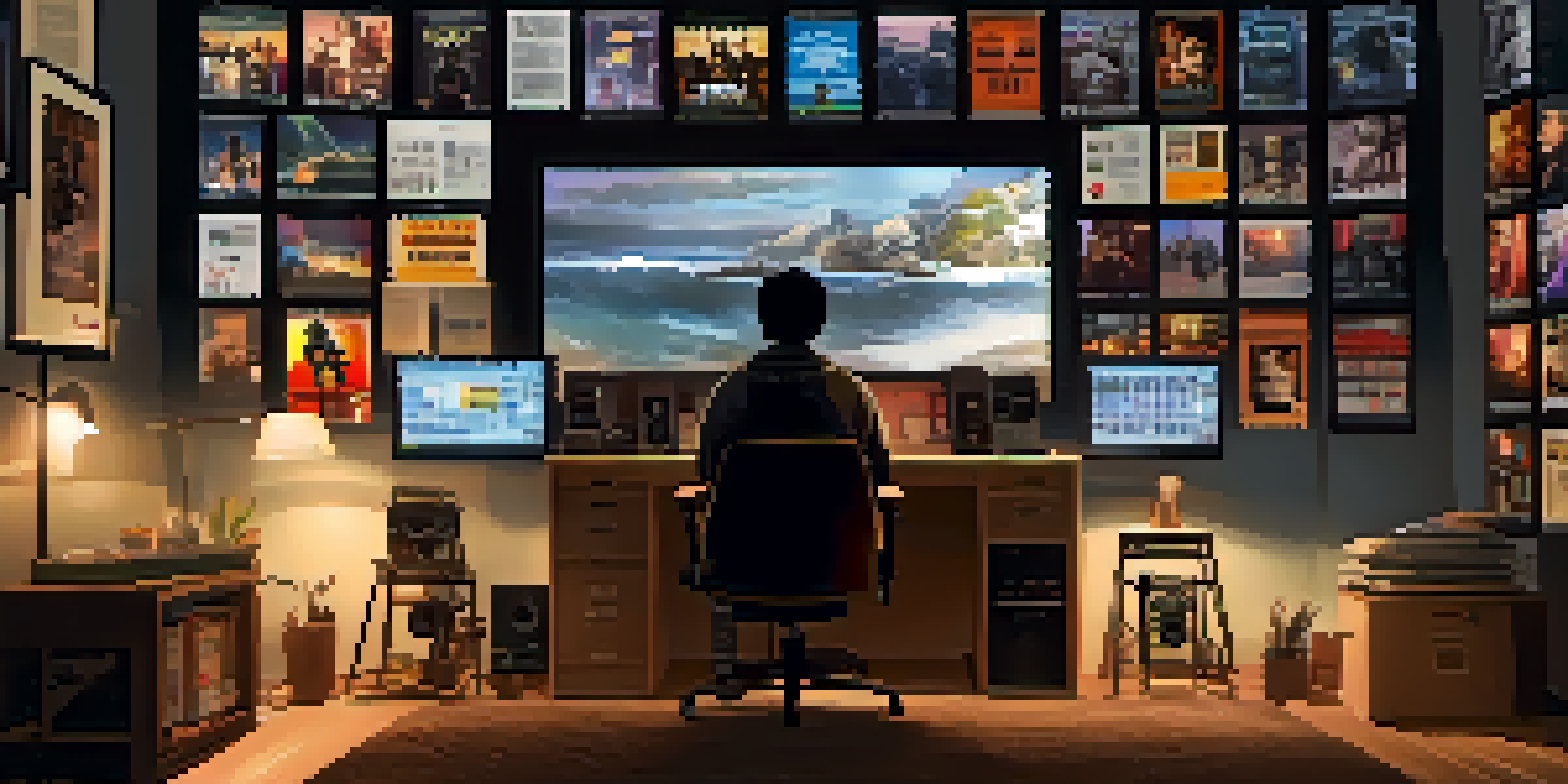Voiceover Narration vs. Dialogue: Enhancing Film Stories

Understanding Voiceover Narration in Film
Voiceover narration serves as a storytelling device that provides insights directly from a character’s perspective. Unlike dialogue, which involves interaction between characters, voiceovers allow filmmakers to convey thoughts and emotions that might otherwise remain unexpressed. This technique can create a deeper connection with the audience as they hear the inner monologue of a character.
The most powerful tool in any filmmaker's arsenal is storytelling, and the voiceover is a unique way to convey the inner thoughts of the characters, adding depth to their journeys.
Think of it as a window into the character's mind; for example, in films like 'The Shawshank Redemption,' Morgan Freeman’s narration adds layers to the story by sharing his reflections. This not only enhances the emotional resonance but also guides viewers through complex themes and backstories. Voiceovers can be particularly effective in establishing tone and atmosphere, setting the stage for the narrative journey.
However, it’s essential to strike a balance—overusing voiceovers can lead to a loss of visual storytelling. While they can enrich the narrative, filmmakers must be cautious not to rely on them too heavily, as this can detract from the potency of the visual medium. Finding the right moments to incorporate voiceovers is key to enhancing the overall storytelling experience.
The Power of Dialogue in Film Storytelling
Dialogue is the heartbeat of film; it’s how characters communicate and interact, revealing their personalities and motivations. Unlike voiceover, dialogue unfolds in real-time, allowing viewers to experience relationships and conflicts firsthand. Strong dialogue can drive the plot forward and create memorable moments that resonate with the audience long after the credits roll.

For instance, in Quentin Tarantino's films, sharp and witty dialogue not only entertains but also builds tension and develops character depth. Each exchange between characters can reveal hidden agendas and emotional stakes, making the audience more invested in the outcome. It’s this dynamic interaction that keeps viewers engaged and eager to see what happens next.
Voiceover Enhances Character Depth
Voiceover narration provides insights into a character’s internal thoughts, enriching the emotional impact of the story.
Moreover, well-crafted dialogue can enhance the realism of a film. When characters speak in a way that feels authentic to their experiences and backgrounds, it adds credibility to the story. This connection to reality can make audiences feel more immersed, as they relate to the characters and their journeys on a personal level.
Combining Voiceover and Dialogue for Impact
The interplay between voiceover narration and dialogue can create a rich tapestry of storytelling. By strategically combining these elements, filmmakers can add depth and complexity to the narrative. For example, a character might express their thoughts through a voiceover while engaging in dialogue with another character, providing a dual perspective that enriches the story.
Dialogue is the lifeblood of cinema; it reveals character, drives the plot, and can turn a simple scene into a memorable moment.
Consider films like 'The Great Gatsby,' where the protagonist’s voiceover reflects his inner struggles while his interactions with other characters reveal the external conflicts. This layering allows audiences to understand both the character’s internal motivations and the external pressures shaping their choices. The result is a more nuanced understanding of the character’s journey.
However, achieving harmony between voiceover and dialogue requires careful planning and execution. Filmmakers need to ensure that both elements complement each other rather than compete for attention. When done right, this combination can elevate the storytelling, making the film an unforgettable experience.
Voiceover Narration: Pros and Cons
Voiceover narration can be a double-edged sword in filmmaking. On one hand, it offers a unique way to share a character’s internal thoughts, providing context and emotional depth that might be challenging to convey through visuals alone. It can also help clarify complex narratives, guiding the audience through intricate plots or historical contexts.
On the other hand, excessive or poorly executed voiceovers can lead to viewer disengagement. If audiences feel overwhelmed by exposition or find the narration distracting, it can detract from the emotional impact of the visuals. Additionally, relying too much on voiceovers can undermine the strength of character development through dialogue and action.
Dialogue Drives Real-Time Interaction
Dialogue reveals character dynamics and motivations, allowing the audience to experience relationships and conflicts in real-time.
Ultimately, the effectiveness of voiceover narration hinges on its execution. When used sparingly and purposefully, it can be a powerful tool for storytelling. However, filmmakers must remain mindful of its limitations to avoid diluting the overall narrative experience.
Dialogue: Strengths and Weaknesses
Dialogue is often hailed as one of the most critical components of film storytelling. Its strengths lie in its ability to convey character dynamics, build tension, and create memorable interactions. Dialogue can reveal subtext and develop relationships, allowing audiences to connect with the characters on a deeper level.
However, dialogue is not without its challenges. Poorly written lines can feel stilted or unrealistic, leading to disengagement from the audience. Additionally, if the dialogue is too expository, it can come off as forced, losing the natural flow of conversation. Striking the right balance between realism and storytelling is crucial for impactful dialogue.
Moreover, the cultural context and character backgrounds should inform dialogue choices. What feels authentic for one character may not resonate with another. Filmmakers must carefully consider the diverse backgrounds of their characters to create dialogue that feels genuine and relatable.
Best Practices for Using Voiceover and Dialogue
To effectively utilize voiceover and dialogue, filmmakers should start by identifying the core message they want to convey. Understanding the character’s journey and the emotional beats of the story will guide decisions on when to employ each technique. It’s important to ask whether voiceover will enhance understanding or if dialogue will better serve the scene.
Additionally, testing different combinations during the editing process can yield valuable insights. Filmmakers can experiment with various voiceover placements alongside dialogue to see what resonates best with the narrative. This trial-and-error approach can lead to surprising discoveries that enhance the overall storytelling.
Combining Techniques for Rich Storytelling
Strategically blending voiceover and dialogue can create a more nuanced narrative, enhancing the overall storytelling experience.
Finally, feedback from test audiences can provide crucial insights into the effectiveness of voiceover and dialogue. Observing audience reactions can help filmmakers gauge what works and what doesn’t, allowing them to fine-tune their approach for maximum impact. Ultimately, the goal is to create a seamless blend of voiceover and dialogue that enriches the film experience.
Conclusion: The Art of Balancing Narration and Dialogue
In conclusion, both voiceover narration and dialogue are powerful storytelling tools that can significantly enhance film narratives. When used thoughtfully, they can complement each other to create a richer, more immersive experience for viewers. The key is to understand the strengths and weaknesses of each technique and apply them in ways that serve the story best.
As filmmakers continue to explore innovative ways to tell their stories, the interplay between voiceover and dialogue will remain an essential consideration. By embracing the unique qualities of both, filmmakers can craft compelling narratives that resonate with audiences on multiple levels.

Ultimately, striking the right balance between voiceover and dialogue can elevate a film from good to great, creating a lasting impact on viewers. Whether through intimate reflections or dynamic exchanges, the art of storytelling thrives on the thoughtful integration of these two vital elements.